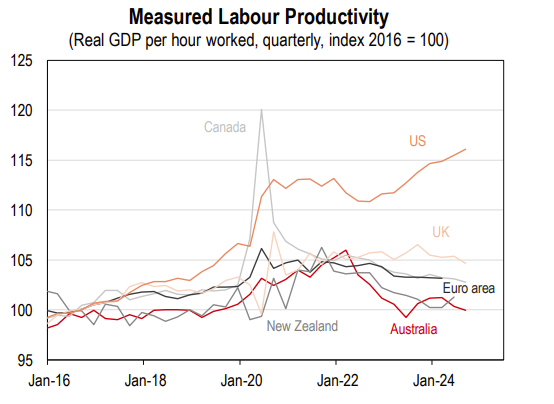Rate cuts won’t save the day: We have a productivity problem
Rate cuts won’t save the day: We have a productivity problem
Australia’s recent popular economic discourse has been dominated by the focus on the cash rate. However, now that rate cuts have begun it is important to understand that a lower cash rate will not deliver sustainable improvements to living standards unless productivity growth picks up.
Monetary policy: A short-term tool
Monetary policy, including adjustments to the cash rate, plays a crucial role in keeping the economy stable. The cash rate, set by the Reserve Bank of Australia (RBA), influences interest rates throughout the economy, impacting borrowing and spending. Lowering the cash rate can stimulate economic activity by making borrowing cheaper and encouraging investment and consumption.
However, while rate cuts provide short-term economic relief, they are not a solution for all economic difficulties. Rate cuts are just tweaks around the edges. They effectively manage economic fluctuations but do not address the core issues that drive long-term economic growth and living standards. For sustainable improvements in living standards, the focus must shift to productivity growth.
The productivity conundrum
Productivity growth, measured as the output produced per hour of work, is a key driver of economic prosperity. Over the past decade, Australia has experienced sluggish productivity growth relative to other developed countries, which has constrained real wage improvements. Without productivity gains, wage increases can lead to inflation, eroding the buying power of wages and causing inefficiencies in the economy.

Source: HSBC Global Research
Several trends contribute to the productivity slump in Australia. The shift from manufacturing to services over the past few decades has played a significant role as services typically have slower productivity growth than manufacturing. Additionally, a recent shift towards non-market sectors to achieve social goals funded by increased government expenditure, such as higher quality care for the elderly and disability services, has further impacted measured productivity. While these non-market outcomes are valuable and improve living standards, they are not counted in traditional measures of productivity like GDP per hour worked.
The construction sector has also faced challenges, with a recent Productivity Commission (PC) report finding a 12 per cent decrease in Gross Value Added (GVA) per hour worked over the past 30 years. Factors contributing to this decline include slow approval processes, a lack of innovation, limited scale, and workforce issues.
Causes of the productivity slump
Several factors have contributed to the decline in productivity:
- Shift from manufacturing to services: services sectors generally have slower productivity growth compared to manufacturing
- Non-market sectors: the focus on non-market outcomes, such as high-quality care services, achieves valuable national objectives but appears less favourable in productivity calculations
- Slowing business dynamism and private investment: reduced business dynamism and capital investment has led to capital shallowing, where businesses invest less in innovative technologies and equipment
- Construction sector challenges: slow approvals, lack of innovation, limited scale, and workforce issues have hampered productivity in the construction sector.
Potential solutions
Addressing the productivity slump requires a multifaceted approach. There is no one solution, but below are some good places to start:
- Changing expectations: acknowledging that pursuing non-market outcomes that improve living standards may lead to slower wage growth in market sectors is crucial. Recognising and valuing these non-market contributions is essential for a balanced economic narrative.
- Better measures of productivity: developing metrics that account for non-market outputs can provide a more accurate picture of economic performance.
- Adoption of technology: embracing AI and other technological advancements can boost productivity across various sectors.
- Policy reforms: implementing policy reforms to enhance business dynamism and investment is critical. In construction, the Productivity Commission report recommends coordinated and transparent planning, reviewing building regulations, removing impediments to innovation, and improving workforce mobility and flexibility.
BDO comment
While monetary policy plays a critical role in economic stability, it is not a solution to long-term economic challenges. Addressing the productivity slump is the key to sustainable improvements in living standards. Australia can enhance its productivity and achieve long-term economic prosperity by recognising the value of non-market outcomes, adopting better productivity measures, embracing technology, and implementing policy reforms.
Our team of economics experts provides a wide range of economic and social research services across Australia. Contact us to discuss your organisation’s needs, or for expert commentary enquiries, contact our media team.